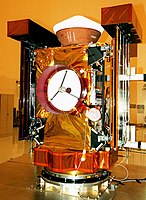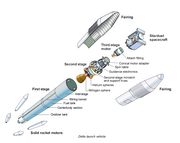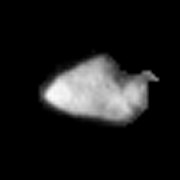
A | B | C | D | E | F | G | H | CH | I | J | K | L | M | N | O | P | Q | R | S | T | U | V | W | X | Y | Z | 0 | 1 | 2 | 3 | 4 | 5 | 6 | 7 | 8 | 9
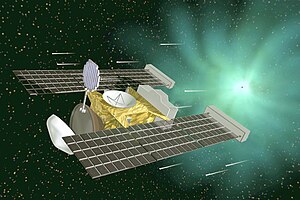 Artist's impression of Stardust at Comet Wild 2 | |||||||||||||
| Names | Discovery 4 Stardust-NExT | ||||||||||||
|---|---|---|---|---|---|---|---|---|---|---|---|---|---|
| Mission type | Sample return | ||||||||||||
| Operator | NASA / JPL | ||||||||||||
| COSPAR ID | 1999-003A | ||||||||||||
| SATCAT no. | 25618 | ||||||||||||
| Website | stardust stardustnext | ||||||||||||
| Mission duration | Stardust: 6 years, 11 months, 7 days NExT: 4 years, 2 months, 7 days Total: 9 years, 1 month, 17 days | ||||||||||||
| Spacecraft properties | |||||||||||||
| Bus | SpaceProbe[1] | ||||||||||||
| Manufacturer | Lockheed Martin University of Washington | ||||||||||||
| Launch mass | 385 kg[2] | ||||||||||||
| Dry mass | 305.397 kg (673 lb)[3] | ||||||||||||
| Dimensions | Bus: 1.71 × 0.66 × 0.66 m[1] (5.6 × 2.16 × 2.16 ft) | ||||||||||||
| Power | 330 W (Solar array / NiH2 batteries) | ||||||||||||
| Start of mission | |||||||||||||
| Launch date | 7 February 1999, 21:04:15.238 UTC[4] | ||||||||||||
| Rocket | Delta II 7426-9.5 #266 | ||||||||||||
| Launch site | Cape Canaveral SLC-17 | ||||||||||||
| Contractor | Lockheed Martin Space Systems | ||||||||||||
| End of mission | |||||||||||||
| Disposal | Decommissioned | ||||||||||||
| Deactivated | Spacecraft: 24 March 2011, 23:33 UTC[5] | ||||||||||||
| Landing date | Capsule: 15 January 2006, 10:12 UTC[6] | ||||||||||||
| Landing site | Utah Test and Training Range 40°21.9′N 113°31.3′W / 40.3650°N 113.5217°W | ||||||||||||
| Flyby of Earth | |||||||||||||
| Closest approach | 15 January 2001, 11:14:28 UTC | ||||||||||||
| Distance | 6,008 km (3,733 mi) | ||||||||||||
| Flyby of asteroid 5535 Annefrank | |||||||||||||
| Closest approach | 2 November 2002, 04:50:20 UTC[7] | ||||||||||||
| Distance | 3,079 km (1,913 mi)[7] | ||||||||||||
| Flyby of periodic comet Wild 2 | |||||||||||||
| Closest approach | 2 January 2004, 19:21:28 UTC[7] | ||||||||||||
| Distance | 237 km (147 mi)[7] | ||||||||||||
| Flyby of Earth (Sample return) | |||||||||||||
| Closest approach | 15 January 2006 | ||||||||||||
| Flyby of Earth | |||||||||||||
| Closest approach | 14 January 2009, 12:33 UTC | ||||||||||||
| Distance | 9,157 km (5,690 mi) | ||||||||||||
| Flyby of Comet Tempel 1 | |||||||||||||
| Closest approach | 15 February 2011, 04:39:10 UTC[8] | ||||||||||||
| Distance | 181 km (112 mi)[9] | ||||||||||||
| |||||||||||||
 
| |||||||||||||
Stardust was a 385-kilogram robotic space probe launched by NASA on 7 February 1999. Its primary mission was to collect dust samples from the coma of comet Wild 2, as well as samples of cosmic dust, and return them to Earth for analysis. It was the first sample return mission of its kind. En route to Comet Wild 2, it also flew by and studied the asteroid 5535 Annefrank. The primary mission was successfully completed on 15 January 2006 when the sample return capsule returned to Earth.[10]
A mission extension, codenamed NExT, culminated in February 2011 with Stardust intercepting Comet Tempel 1, a small Solar System body previously visited by Deep Impact in 2005. Stardust ceased operations in March 2011.
On 14 August 2014, scientists announced the identification of possible interstellar dust particles from the Stardust capsule returned to Earth in 2006.[11][12][13][14]
Mission background
History
Beginning in the 1980s, scientists began seeking a dedicated mission to study a comet. During the early 1990s, several missions to study Comet Halley became the first successful missions to return close-up data. However, the US cometary mission, Comet Rendezvous Asteroid Flyby, was canceled for budgetary reasons. In the mid-1990s, further support was given to a cheaper, Discovery-class mission that would study Comet Wild 2 in 2004.[1]
Stardust was competitively selected in the fall of 1995 as a NASA Discovery Program mission of low-cost with highly focused science goals.[1]: 5 Construction of Stardust began in 1996, and was subject to the maximum contamination restriction, level 5 planetary protection. However, the risk of interplanetary contamination by alien life was judged low,[15] as particle impacts at over 450 metres per second (1,000 mph), even into aerogel, were believed to be terminal for any known microorganism.[1]: 22–23
Comet Wild 2 was selected as the primary target of the mission for the rare chance to observe a long-period comet that has ventured close to the Sun. The comet has since become a short period comet after an event in 1974, where the orbit of Wild 2 was affected by the gravitational pull of Jupiter, moving the orbit inward, closer to the Sun. In planning the mission, it was expected that most of the original material from which the comet formed would still be preserved.[1]: 5
The primary science objectives of the mission included:[7]
- Providing a flyby of a comet of interest (Wild 2) at a sufficiently low velocity (less than 6.5 km/s) such that non-destructive capture of comet dust is possible using an aerogel collector.
- Facilitating the intercept of significant numbers of interstellar dust particles using the same collection medium, also at as low a velocity as possible.
- Returning as many high-resolution images of the comet coma and nucleus as possible, subject to the cost constraints of the mission.
The spacecraft was designed, built and operated by Lockheed Martin Astronautics as a Discovery-class mission in Denver, Colorado. JPL provided mission management for the NASA division for mission operations. The principal investigator of the mission was Dr. Donald Brownlee from the University of Washington.[1]: 5
Spacecraft design
The spacecraft bus measured 1.7 meters (5 ft 7 in) in length, and 0.66 meters (2 ft 2 in) in width, a design adapted from the SpaceProbe deep space bus developed by Lockheed Martin Astronautics. The bus was primarily constructed with graphite fiber panels with an aluminum honeycomb support structure underneath; the entire spacecraft was covered with polycyanate, Kapton sheeting for further protection. To maintain low costs, the spacecraft incorporated many designs and technologies used in past missions or previously developed for future missions by the Small Spacecraft Technologies Initiative (SSTI). The spacecraft featured five scientific instruments to collect data, including the Stardust Sample Collection tray, which was brought back to Earth for analysis.[16]
Attitude control and propulsion
The spacecraft was three-axis stabilized with eight 4.41 N hydrazine monopropellant thrusters, and eight 1 N thrusters to maintain attitude control (orientation); necessary minor propulsion maneuvers were performed by these thrusters as well. The spacecraft was launched with 80 kilograms of propellant. Information for spacecraft positioning was provided by a star camera using FSW to determine attitude (Stellar Compass), an inertial measurement unit, and two Sun sensors.[1]: 30–31 [16] The Stellar Compass software was provided by Intelligent Decisions, Inc.
Communications
For communicating with the Deep Space Network, the spacecraft transmitted data across the X-band using a 0.6-meter (2 ft 0 in) parabolic high-gain antenna, medium-gain antenna (MGA) and low-gain antennas (LGA) depending on mission phase, and a 15-watt transponder design originally intended for the Cassini spacecraft.[1]: 32 [16]
Power
The probe was powered by two solar arrays, providing an average of 330 watts of power. The arrays also included Whipple shields to protect the delicate surfaces from the potentially damaging cometary dust while the spacecraft was in the coma of Wild 2. The solar array design was derived primarily from the Small Spacecraft Technology Initiative (SSTI) spacecraft development guidelines. The arrays provided a unique method of switching strings from series to parallel depending on the distance from the Sun. A single nickel–hydrogen (NiH2) battery was also included to provide the spacecraft with power when the solar arrays received too little sunlight.[1]: 31 [16]
Computer
The computer on the spacecraft operated using a radiation-hardened RAD6000 32-bit processor card. For storing data when the spacecraft was unable to communicate with Earth, the processor card was able to store 128 megabytes, 20% of which was occupied by the flight system software. The system software is a form of VxWorks, an embedded operating system developed by Wind River Systems.[1]: 31 [16]
Scientific instruments
| Navigation Camera (NC) | |||

|
The camera is intended for targeting comet Wild 2 during the flyby of the nucleus. It captures black and white images through a filter wheel making it possible to assemble color images and detect certain gas and dust emissions in the coma. It also captures images at various phase angles, making it possible to create a three-dimensional model of a target to better understand the origin, morphology, and mineralogical inhomogeneities on the surface of the nucleus. The camera utilizes the optical assembly from the Voyager Wide Angle Camera. It is additionally fitted with a scanning mirror to vary the viewing angle and avoid potentially damaging particles. For environmental testing and verification of the NAVCAM the only remaining Voyager spare camera assembly was used as a collimator for testing of the primary imaging optics. A target at the focal point of the spare was imaged through the optical path of the NAVCAM for verification.[17][18]
| ||
| Cometary and Interstellar Dust Analyzer (CIDA) | |||
The dust analyzer is a mass spectrometer able to provide real-time detection and analysis of certain compounds and elements. Particles enter the instrument after colliding with a silver impact plate and traveling down a tube to the detector. The detector is then able to detect the mass of separate ions by measuring the time taken for each ion to enter and travel through the instrument. Identical instruments were also included on Giotto and Vega 1 and 2.[19][20]
| |||
| Dust Flux Monitor Instrument (DFMI) | |||

|
Located on the Whipple shield at the front of the spacecraft, the sensor unit provides data regarding the flux and size distribution of particles in the environment around Wild 2. It records data by generating electric pulses as a special polarized plastic (PVDF) sensor is struck by high energy particles as small as a few micrometers.[21][22]
| ||
| Stardust Sample Collection (SSC) | |||
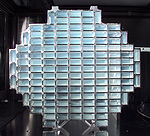
|
The particle collector uses aerogel, a low-density, inert, microporous, silica-based substance, to capture dust grains as the spacecraft passes through the coma of Wild 2. After sample collection was complete, the collector receded into the Sample Return Capsule for entering the Earth's atmosphere. The capsule with encased samples would be retrieved from Earth's surface and studied.[23][24]
| ||
| Dynamic Science Experiment (DSE) | |||
The experiment will primarily utilize the X band telecommunications system to conduct radio science on Wild 2, to determine the mass of the comet; secondarily the inertial measurement unit is utilized to estimate the impact of large particle collisions on the spacecraft.[25][26]
| |||
Sample collection
Comet and interstellar particles are collected in ultra low density aerogel. The tennis racket-sized collector tray contained ninety blocks of aerogel, providing more than 1,000 square centimeters of surface area to capture cometary and interstellar dust grains.
To collect the particles without damaging them, a silicon-based solid with a porous, sponge-like structure is used in which 99.8 percent of the volume is empty space. Aerogel has 1⁄1000 the density of glass, another silicon-based solid to which it may be compared. When a particle hits the aerogel, it becomes buried in the material, creating a long track, up to 200 times the length of the grain. The aerogel was packed in an aluminium grid and fitted into a Sample Return Capsule (SRC), which was to be released from the spacecraft as it passed Earth in 2006.
To analyze the aerogel for interstellar dust, one million photographs will be needed to image the entirety of the sampled grains. The images will be distributed to home computer users to aid in the study of the data using a program titled, Stardust@home. In April 2014, NASA reported they had recovered seven particles of interstellar dust from the aerogel.[27]
Stardust microchip
Stardust was launched carrying two sets of identical pairs of square 10.16-centimeter (4 in) silicon wafers. Each pair featured engravings of well over one million names of people who participated in the public outreach program by filling out internet forms available in late 1997 and mid-1998. One pair of the microchips was positioned on the spacecraft and the other was attached to the sample return capsule.[1]: 24
Mission profile
Launch and trajectory

Stardust · 81P/Wild · Earth · 5535 Annefrank · Tempel 1
Stardust was launched at 21:04:15 UTC on 7 February 1999, by the National Aeronautics and Space Administration from Space Launch Complex 17A at the Cape Canaveral Air Force Station in Florida, aboard a Delta II 7426 launch vehicle. The complete burn sequence lasted for 27 minutes bringing the spacecraft into a heliocentric orbit that would bring the spacecraft around the Sun and past Earth for a gravity assist maneuver in 2001, to reach asteroid 5535 Annefrank in 2002 and Comet Wild 2 in 2004 at a low flyby velocity of 6.1 km/s. In 2004, the spacecraft performed a course correction that would allow it to pass by Earth a second time in 2006, to release the Sample Return Capsule for a landing in Utah in the Bonneville Salt Flats.[1]: 14–22 [7]
During the second encounter with Earth, the Sample Return Capsule was released on Jan 15, 2006.[7] Immediately afterwards, Stardust was put into a "divert maneuver" to avoid entering the atmosphere alongside the capsule. Under twenty kilograms of propellant remained onboard after the maneuver.[7] On 29 January 2006, the spacecraft was put in hibernation mode with only the solar panels and receiver active, in a 3-year heliocentric orbit that would return it to Earth vicinity on 14 January 2009.[7][28]
A subsequent mission extension was approved on 3 July 2007, to bring the spacecraft back to full operation for a flyby of Comet Tempel 1 in 2011. The mission extension was the first to revisit a small Solar System body and used the remaining propellant, signaling the end of the useful life for the spacecraft.[29]
| Timeline of travel[7][30] | ||||||||||||||||||||||||||||||||||||||||||||||||||||||||||||||||||||||||||||||||||||||||||||||||||||||||||||||||||||||
|---|---|---|---|---|---|---|---|---|---|---|---|---|---|---|---|---|---|---|---|---|---|---|---|---|---|---|---|---|---|---|---|---|---|---|---|---|---|---|---|---|---|---|---|---|---|---|---|---|---|---|---|---|---|---|---|---|---|---|---|---|---|---|---|---|---|---|---|---|---|---|---|---|---|---|---|---|---|---|---|---|---|---|---|---|---|---|---|---|---|---|---|---|---|---|---|---|---|---|---|---|---|---|---|---|---|---|---|---|---|---|---|---|---|---|---|---|---|---|
| ||||||||||||||||||||||||||||||||||||||||||||||||||||||||||||||||||||||||||||||||||||||||||||||||||||||||||||||||||||||
Encounter with Annefrank
At 04:50:20 UTC on 2 November 2002, Stardust encountered asteroid 5535 Annefrank from a distance of 3,079 km (1,913 mi).[7] The solar phase angle ranged from 130 degrees to 47 degrees during the period of observations. This encounter was used primarily as an engineering test of the spacecraft and ground operations in preparation for the encounter with Comet Wild 2 in 2003.[7]
Encounter with Wild 2
At 19:21:28 UTC, on 2 January 2004, Stardust encountered Comet Wild 2[34] on the sunward side with a relative velocity of 6.1 km/s at a distance of 237 km (147 mi).[7] The original encounter distance was planned to be 150 km (93 mi), but this was changed after a safety review board increased the closest approach distance to minimize the potential for catastrophic dust collisions.[7]
The relative velocity between the comet and the spacecraft was such that the comet actually overtook the spacecraft from behind as they traveled around the Sun. During the encounter, the spacecraft was on the Sunlit side of the nucleus, approaching at a solar phase angle of 70 degrees, reaching a minimum angle of 3 degrees near closest approach and departing at a phase angle of 110 degrees.[7] The AutoNav software was used during the flyby.[35]: 11
During the flyby the spacecraft deployed the Sample Collection plate to collect dust grain samples from the coma, and took detailed pictures of the icy nucleus.[36]
New Exploration of Tempel 1 (NExT)

On 19 March 2006, Stardust scientists announced that they were considering the possibility of redirecting the spacecraft on a secondary mission to image Comet Tempel 1. The comet was previously the target of the Deep Impact mission in 2005, sending an impactor into the surface. The possibility of this extension could be vital for gathering images of the impact crater which Deep Impact was unsuccessful in capturing due to dust from the impact obscuring the surface.
Zdroj:https://en.wikipedia.org?pojem=Stardust_(spacecraft)
Text je dostupný za podmienok Creative Commons Attribution/Share-Alike License 3.0 Unported; prípadne za ďalších podmienok. Podrobnejšie informácie nájdete na stránke Podmienky použitia.
Antropológia
Aplikované vedy
Bibliometria
Dejiny vedy
Encyklopédie
Filozofia vedy
Forenzné vedy
Humanitné vedy
Knižničná veda
Kryogenika
Kryptológia
Kulturológia
Literárna veda
Medzidisciplinárne oblasti
Metódy kvantitatívnej analýzy
Metavedy
Metodika
Text je dostupný za podmienok Creative
Commons Attribution/Share-Alike License 3.0 Unported; prípadne za ďalších
podmienok.
Podrobnejšie informácie nájdete na stránke Podmienky
použitia.
www.astronomia.sk | www.biologia.sk | www.botanika.sk | www.dejiny.sk | www.economy.sk | www.elektrotechnika.sk | www.estetika.sk | www.farmakologia.sk | www.filozofia.sk | Fyzika | www.futurologia.sk | www.genetika.sk | www.chemia.sk | www.lingvistika.sk | www.politologia.sk | www.psychologia.sk | www.sexuologia.sk | www.sociologia.sk | www.veda.sk I www.zoologia.sk




